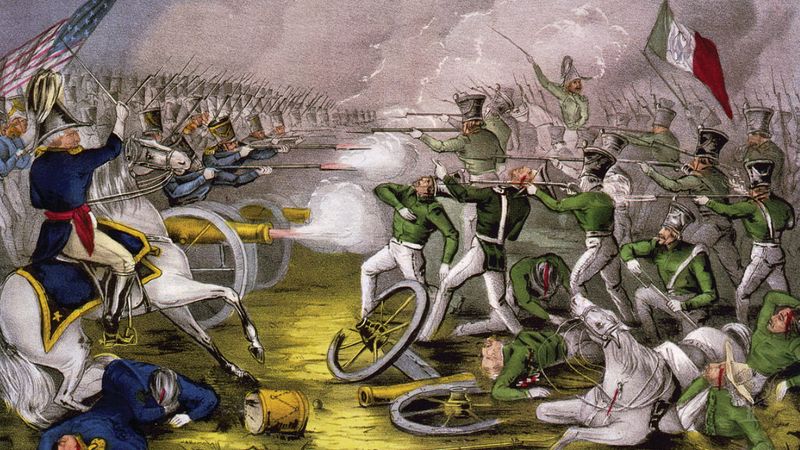April 25, 1846, marked a turning point in the history of both Mexico and the United States, as it marked the beginning of the Mexican-American War. This conflict, fueled by territorial disputes and cultural clashes, ultimately reshaped the borders of not only these two nations but also the wider geopolitical landscape of North America.
The origins of the Mexican-American War can be traced back to the annexation of Texas by the United States in 1845. The Mexican government vehemently opposed this move, as they considered Texas to be a rebellious province rather than an independent nation. The tense relations between the two countries quickly escalated, leading to a torrent of rhetoric and military actions that would bring about a full-scale war.
On that fateful day in April, Mexican troops, who saw the presence of American soldiers on the Rio Grande as an intrusion onto their sovereign territory, engaged in a skirmish with American forces. This clash, known as the Thornton Affair, served as the proverbial spark that ignited the flames of war. Following this event, President James K. Polk, eager to expand American influence and acquire more land, urged Congress to declare war and authorized a full-scale invasion of Mexico.
Over the course of the next two years, the Mexican-American War witnessed a series of decisive battles and campaigns that forever altered the course of history. From the grueling fighting at Buena Vista and Monterrey to the iconic Siege of Veracruz and the Battle of Chapultepec, both sides displayed remarkable military strategy and valor.
However, as the war progressed, it became increasingly apparent that the American military machine was overpowering Mexican forces. The substantial technological and numerical advantages of the United States ultimately tipped the scales in their favor. Despite the Mexican government’s efforts to resist the invasion, American troops steadily advanced deeper into Mexican territory, culminating in the capture of Mexico City in September 1847.
Ultimately, the Treaty of Guadalupe Hidalgo, signed on February 2, 1848, brought the Mexican-American War to a formal conclusion. Under the terms of this treaty, Mexico was forced to cede vast amounts of land, including present-day California, Nevada, Utah, Arizona, New Mexico, and parts of Colorado and Wyoming, to the United States.
The Mexican-American War was a conflict of immense significance, shaping the destiny and identity of both nations involved. For Mexico, this war resulted in a profound loss of territory, while for the United States, it fulfilled the spirit of Manifest Destiny and dramatically increased its landmass. Beyond the immediate consequences, the war also intensified tensions between the two countries, contributing to a strained relationship that can still be felt to this day.
In conclusion, the Mexican-American War began on April 25, 1846, marked by a series of skirmishes and military actions. Its far-reaching impacts still reverberate through the collective memories of both Mexico and the United States, forever shaping their history and forging a deeper understanding of the complex dynamics inherent in international relations.
More About : When Did The Mexican American War Start
Introduction (100 words):
The Mexican-American War, a conflict that profoundly shaped the political landscape of North America, began on April 25, 1846. This historical event played a crucial role in defining borders and determining the fate of vast territories now known as the American Southwest. The origins of the war can be traced back to various political disputes, territorial ambitions, and ideological tensions between the United States and Mexico. This article will delve into the circumstances leading to the war, highlight the major events during its course, and examine the outcome that reshaped the destiny of both nations.
Background and Causes (150 words):
The establishment of the independent Republic of Mexico in 1821 opened doors to an expansionist vision for both Mexico and the United States. The young American republic had a growing appetite for land, while Mexico sought to solidify its control over the northern frontier. However, disagreements over disputed territories, such as Texas and the border between the Nueces River and the Rio Grande, ignited tensions between the two nations. Additionally, America’s belief in Manifest Destiny, the idea that the United States was destined to stretch across the continent, further exacerbated the situation. These factors, combined with economic interests, played a pivotal role in setting the stage for conflict.
Declaration of War and Major Events (200 words):
The Mexican-American War officially commenced when a detachment of American troops led by General Zachary Taylor clashed with Mexican forces in the disputed border territory. President James K. Polk, fueled by expansionist desires and the belief that Mexico had provoked the conflict, successfully pushed Congress to declare war on May 13, 1846. The war witnessed several significant events, including the Battles of Palo Alto, Monterrey, and Buena Vista, where American forces achieved notable victories against Mexican opponents. However, the most renowned event was the U.S. invasion of Mexico City in September 1847, led by General Winfield Scott. This decisive moment virtually ensured U.S. victory and forced Mexico to negotiate peace, culminating in the signing of the Treaty of Guadalupe Hidalgo on February 2, 1848.
Outcome and Impact (150 words):
The Treaty of Guadalupe Hidalgo brought substantial territorial gains for the United States. Mexico ceded approximately half of its territory, including the present-day states of California, Nevada, Utah, Arizona, New Mexico, parts of Colorado, and Wyoming, as well as parts of Kansas and Oklahoma. These acquisitions fueled America’s rapid westward expansion, transforming it into a continental power. Conversely, Mexico suffered immense devastation, losing almost 55% of its territory. The war also worsened tensions between the North and South in the United States, as the issue of expanding slavery into newly acquired territories became a significant point of contention, ultimately leading to the American Civil War.
Conclusion (100 words):
The Mexican-American War, which began in 1846, marked a critical turning point in the history of Mexico and the United States. The conflict, rooted in territorial ambitions, economic interests, and ideological differences, shaped the future of North America. Through various key events, the United States emerged victorious, obtaining vast amounts of territory that facilitated its expansion. Conversely, Mexico suffered significant territorial losses, leading to political and economic instability that still reverberates today. The war’s aftermath intensified regional tensions within the United States and became a catalyst for the protracted struggle over slavery, culminating in the Civil War.
FAQs on When Did The Mexican American War Start
Q: When did the Mexican-American War start?
A: The Mexican-American War started on April 25, 1846.
Q: What were the main causes of the Mexican-American War?
A: The main causes of the Mexican-American War were the annexation of Texas by the United States and territorial disputes over the Texas-Mexico border.
Q: How long did the Mexican-American War last?
A: The Mexican-American War lasted for two years, from 1846 to 1848.
Q: Who were the key figures involved in the Mexican-American War?
A: The key figures involved in the Mexican-American War were President James K. Polk of the United States and Mexican President José Joaquín de Herrera.
Q: What were the major battles of the Mexican-American War?
A: The major battles of the Mexican-American War included the Battle of Palo Alto, the Battle of Monterrey, the Battle of Buena Vista, and the Battle of Mexico City.
Q: How did the Mexican-American War end?
A: The Mexican-American War ended with the signing of the Treaty of Guadalupe Hidalgo on February 2, 1848.
Q: What were the terms of the Treaty of Guadalupe Hidalgo?
A: The Treaty of Guadalupe Hidalgo granted the United States the territories of California, Nevada, Utah, New Mexico, Arizona, Colorado, Wyoming, Kansas, and parts of Oklahoma, Texas, and Montana. It also established the Rio Grande as the border between Mexico and the United States.
Q: What were the consequences of the Mexican-American War?
A: The consequences of the Mexican-American War included the acquisition of significant territory by the United States, the exacerbation of tensions between the North and the South over the expansion of slavery, and strained relations between Mexico and the United States for many years.
Q: How many people died during the Mexican-American War?
A: It is estimated that around 13,000 American soldiers and 25,000 Mexican soldiers lost their lives during the Mexican-American War.
Q: How did the Mexican-American War affect the indigenous population?
A: The Mexican-American War negatively impacted the indigenous population as their lands and resources were often disregarded or taken away by the conquering forces. Additionally, the war exacerbated existing injustices and unequal treatment towards indigenous communities.




